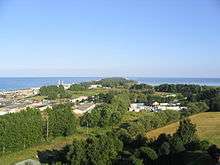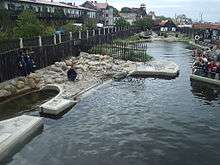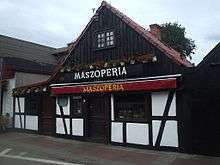Hel Peninsula
Hel Peninsula (![]()
Hel | |
|---|---|
Peninsula | |
 Hel Peninsula as seen from Landsat satellite in 2000 | |
 Hel | |
| Coordinates: 54°38′30″N 18°46′53″E | |
| Country | |
| Voivodeship | Pomeranian |
| County | Puck |



Name
The name of the peninsula could come from old-Polish word "hyl/hel" meaning empty, exposed place or from the Germanic word heel derived from the form of the peninsula and the fact that the area first settled by the eastgermanic Goths tribe.[1]
Geography
The width of the peninsula varies from approximately 300 m near Jurata, through 100 m in the most narrow part to over 3 km at the tip. Since the peninsula was formed entirely of sand, it is frequently turned into an island by winter storms. Until the 17th century the peninsula was a chain of islands that formed a strip of land only during the summer.
A road and a railroad run along the peninsula from the mainland to the town located at the furthest point, Hel, a popular tourist destination. Other towns, ports, and tourist resorts are Jurata, Jastarnia, Chłapowo, Kuźnica, Chałupy, and Władysławowo.
Bus transport on peninsula consists of only one route – 666.[2]
Military importance
The Hel (German: Hela) Peninsula was part of Prussia and then Germany from 1772 until 1919. After the peninsula became part of the Second Polish Republic after World War I, it acquired considerable military significance (Polish Corridor), and was turned into a fortified region, with a garrison of about 3,000. In the course of the Battle of Hel in 1939, Polish forces dynamited the peninsula at one point, turning it into an island.
During the years of German occupation (1939–1945), Hel's defenses were further expanded, and a battery of three 40.6 cm SK C/34 gun was constructed, though the guns were soon moved to the Atlantic Wall in occupied France. The peninsula remained in German hands until the end of World War II, when the defending forces surrendered on May 14, 1945, six days after Germany had capitulated.
After the war, when Hel again became part of Poland, it continued to have military significance, with much of its area reserved for military use. Additional gun batteries were built during the 1940s and 1950s. Today many of the fortifications and batteries are open to tourists, though some areas of the peninsula still belong to the Polish Armed Forces.
See also
- Hel Fortified Area
- Westerplatte
- Hel lighthouse
